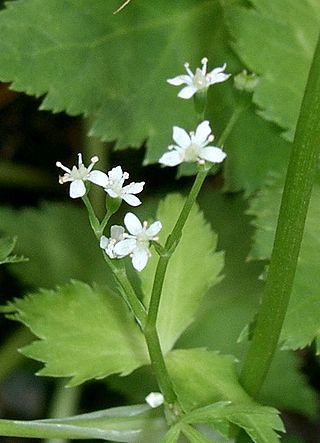
Honeysuckles are arching shrubs or twining vines in the genus Lonicera of the family Caprifoliaceae. It includes 158 species native to northern latitudes in North America, Eurasia, and North Africa. Widely known species include Lonicera periclymenum, Lonicera japonica and Lonicera sempervirens. L. japonica is a highly invasive species considered a significant pest in parts of North America, Europe, South America, Australia, and Africa.

Cryptomeria is a monotypic genus of conifer in the cypress family Cupressaceae. It includes only one species, Cryptomeria japonica. It used to be considered by some to be endemic to Japan, where it is known as Sugi. The tree is called Japanese cedar or Japanese redwood in English. It has been extensively introduced and cultivated for wood production on the Azores.

Lonicera japonica, known as Japanese honeysuckle and golden-and-silver honeysuckle, is a species of honeysuckle native to East Asia, including many parts of China. It is often grown as an ornamental plant, but has become an invasive species in a number of countries. Japanese honeysuckle is used in traditional Chinese medicine.

Camellia japonica, known as common camellia, or Japanese camellia, is a species of Camellia, a flowering plant genus in the family Theaceae. There are thousands of cultivars of C. japonica in cultivation, with many colors and forms of flowers. Despite its common name, it is native to China, not Japan. The cultivation of Camellia japonica also started in China. Its widespread cultivation can be traced back to the Song Dynasty, when 15 varieties of Camellia japonica were recorded in literature. It was later introduced to Japan. It grows in forests, at altitudes of around 300–1,100 metres (980–3,600 ft).

Cryptotaenia japonica, commonly called mitsuba, Japanese wild parsley and Japanese honewort among other names, is a herbaceous perennial plant in the celery family native to Japan, Korea and China. The plant is edible and is commonly used as a garnish and root vegetable in Japan, and other Asian countries. It is sometimes considered a subspecies of Cryptotaenia canadensis as Cryptotaenia canadensis subsp. japonica.

Ulmus davidiana var. japonica, the Japanese elm, is one of the larger and more graceful Asiatic elms, endemic to much of continental northeast Asia and Japan, where it grows in swamp forest on young alluvial soils, although much of this habitat has now been lost to intensive rice cultivation.

Japonica rice, sometimes called sinica rice, is one of the two major domestic types of Asian rice varieties. Japonica rice is extensively cultivated and consumed in East Asia, whereas in most other regions indica rice is the dominant type of rice. Japonica rice originated from Central China, where it was first domesticated along the Yangtze River basin approximately 9,500 to 6,000 years ago.

Teniloxazine, also known as sufoxazine and sulfoxazine, is a drug which is marketed in Japan. Though initially investigated as a neuroprotective and nootropic agent for the treatment of cerebrovascular insufficiency in the 1980s, it was ultimately developed and approved as an antidepressant instead. It acts as a potent norepinephrine reuptake inhibitor, with fair selectivity over the serotonin and dopamine transporters, and also behaves as an antagonist of the 5-HT2A receptor.

Rhodopina is a genus of longhorn beetles of the subfamily Lamiinae, containing the following species:
The hybrid elm Ulmus davidianavar.japonica × U. minor was raised at the Arnold Arboretum before 1924.
Rhodopina nilghirica is a species of beetle in the family Cerambycidae. It was described by Stephan von Breuning in 1939.
Rhodopina similis is a species of beetle in the family Cerambycidae. It was described by Stephan von Breuning in 1940.
Rhodopina tubericollis is a species of beetle in the family Cerambycidae. It was described by Stephan von Breuning in 1943. It is known from Borneo.
Rhodopina laevepunctata is a species of beetle in the family Cerambycidae. It was described by Stephan von Breuning in 1958.
Rhodopina parassamensis is a species of beetle in the family Cerambycidae. It was described by Stephan von Breuning in 1975.
Rhodopina alboplagiata is a species of beetle in the family Cerambycidae. It was described by Charles Joseph Gahan in 1890. It is known from India.
Rhodopina lewisii is a species of beetle in the family Cerambycidae. It was described by Henry Walter Bates in 1873.
Rhodopina okinoerabuana is a species of beetle in the family Cerambycidae. It was described by Masao Hayashi in 1966. It is known from Japan.
Rhodopina piperita is a species of beetle in the family Cerambycidae. It was described by Charles Joseph Gahan in 1890.
Rhodopina tokarensis is a species of beetle in the family Cerambycidae. It was described by Masao Hayashi in 1956.








